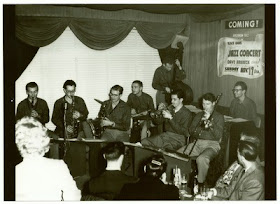 |
| Album cover of The Dave Brubeck Octet, with cover art by Arnold Roth, who did many covers for the Fantasy jazz label, 1956. |
 |
| One of the only photographs of the Dave Brubeck Octet in concert. Paul Desmond is second from the left, Cal Tjader is on the drums, and Brubeck is in the back, at the piano. |
Recorded between 1946 and 1950, the 18 tracks on the album The Dave Brubeck Octet offers up the fruits
of the very first recording sessions that Dave Brubeck participated in. The 18
tracks were issued in different formats during the early 1950’s, and then in
1956 combined into one 12-inch LP, featuring the same track listing found on
the CD.
The Dave Brubeck Octet was comprised of composers and
musicians who would go on to have a significant impact on jazz music in the
1950’s and beyond. The Octet was: Brubeck on piano, Bob Collins on baritone
saxophone, David Van Kriedt on tenor sax, Dick Collins on trumpet, Bill Smith
on clarinet, credited on this release as William O. Smith, Jack Weeks on bass,
Cal Tjader on drums, and an alto sax player named Paul Desmond. Brubeck had met
Desmond when they were both in the Army, and they would go on to play together,
off and on, but mostly on, until Desmond’s death in 1977.
Brubeck had studied music at the College of the Pacific and
at Mills College, and had managed to get through his studies without learning
how to read music. The dean at College of the Pacific told Brubeck that he
couldn’t let him graduate without learning how to read music. But several
professors stuck up for Brubeck’s talents, and COP let him graduate as long as
he promised not to teach music.
Many members of the Octet had studied under the French
composer Darius Milhaud at Mills College, and they shared an interest in polytonality
and counterpoint. The Dave Brubeck Octet is
an interesting record—it has at least a surface similarity to Miles Davis’ nonet
recordings of the late 1940’s, released under the title Birth of the Cool. Both recordings were influenced by classical music,
but where Birth of the Cool has
gained considerable critical acclaim, the recordings by Brubeck’s Octet have
languished in obscurity.
About half of the songs on the Octet album are lightly swinging versions of jazz standards, “The
Way You Look Tonight,” “Love Walked In,” “Let’s Fall in Love,” “You Go to My
Head.” In part because of the limitations of recordings of the time, almost all
of the tracks are three minutes or less, so there’s not a lot of solo space. One
of the more interesting songs on the album is “How High the Moon,” which the
group plays in various different jazz styles, taking it from Dixieland to bebop,
with an uncredited narrator guiding us through the different styles. On that
song the listener is able to hear the versatility of the group. Brubeck’s piano
playing is smoother than it would be with his famous Quartet—we
don’t hear much of the block chords that would be one of his trademarks later
on, although some crop up on his solo on “Laura,” a tune that Brubeck would
soon re-record with his trio of Ron Crotty on bass and Cal Tjader on drums.
What’s interesting about the Octet for fans of Brubeck’s music
is how early he was interested in polytonality, which would be one of the musical
subjects that he returned to again and again throughout his career.
On The Dave Brubeck
Octet we also get to hear Brubeck’s debut as a composer. He wrote three
songs on the album: “Playland-at-the-Beach,” “Rondo,” and “Closing Theme.” Interestingly,
Brubeck doesn’t play the piano on either “Playland-at-the-Beach” or “Rondo,”
which both sound like exercises written for the classroom.
The Dave Brubeck Octet
isn’t quite essential Dave Brubeck, but it’s worth listening to if you’re
interested in learning more about Brubeck’s roots, or if you’re a fan of West
Coast jazz or Third Stream jazz.
Two points of interest for the author & perhaps other readers. A website, allmusic.com, attributes the narration to Jimmy Lyons, a saxophonist, who later in life often played with Cecil Taylor. As for Dave Brubeck's playing style, after this recording, Brubeck had an accident diving into the surf in Hawaii. He was severely injured and, afterwards, suffered from pain in his hands. This limited his dexterity and may account for the block-chord style in his later recordings. This recording, therefore, possesses even more historical importance (apart from what it holds for the development of cool jazz) and presents a unique (never-to-be repeated) moment in time for Dave Brubeck, as a pianist.
ReplyDelete